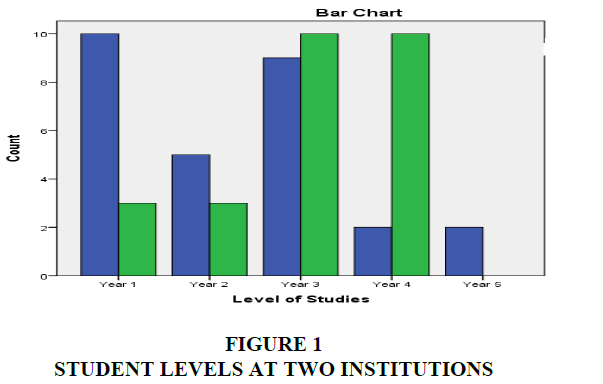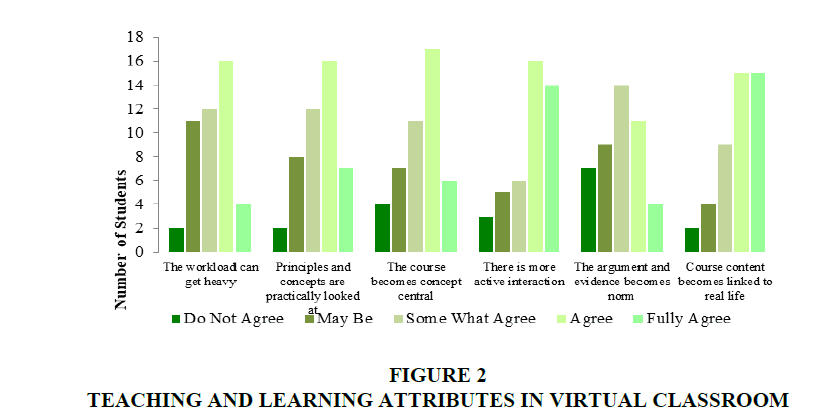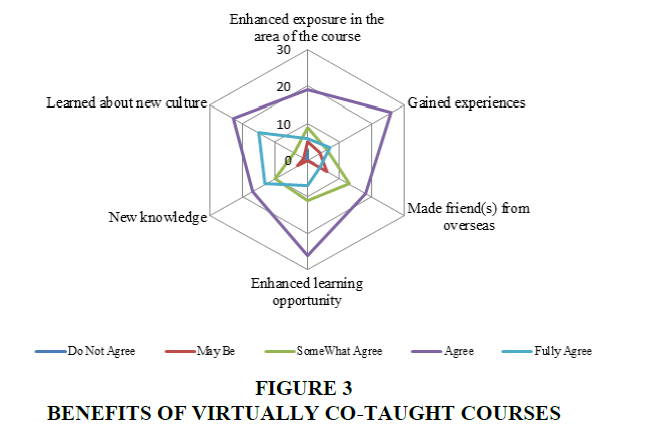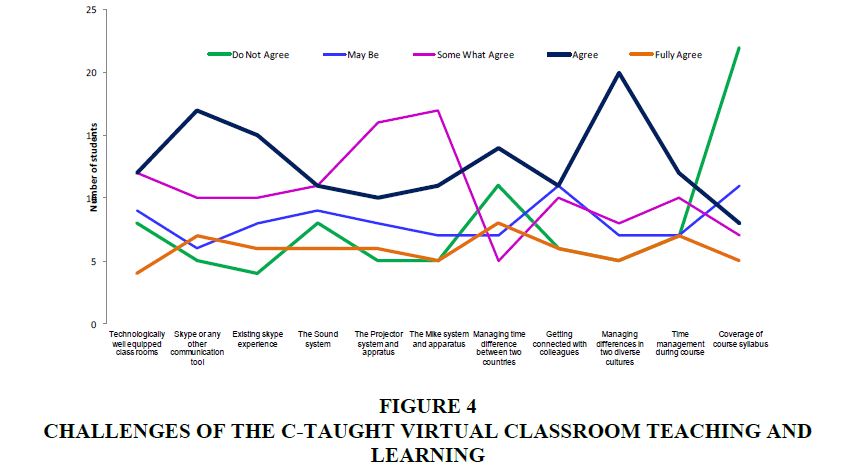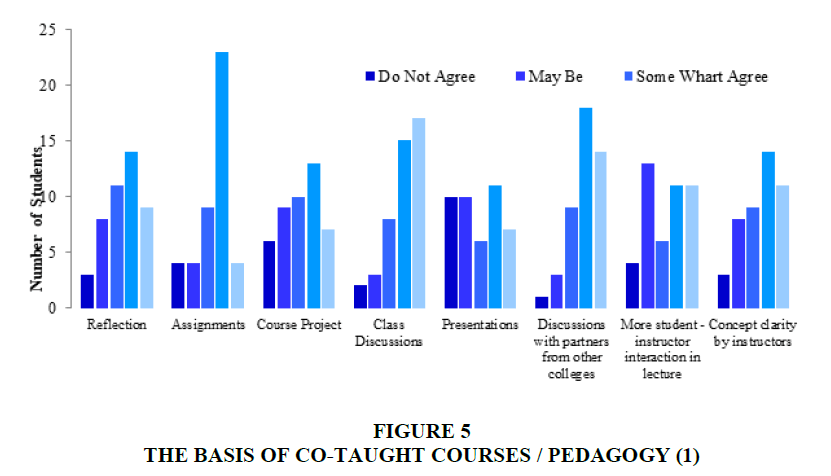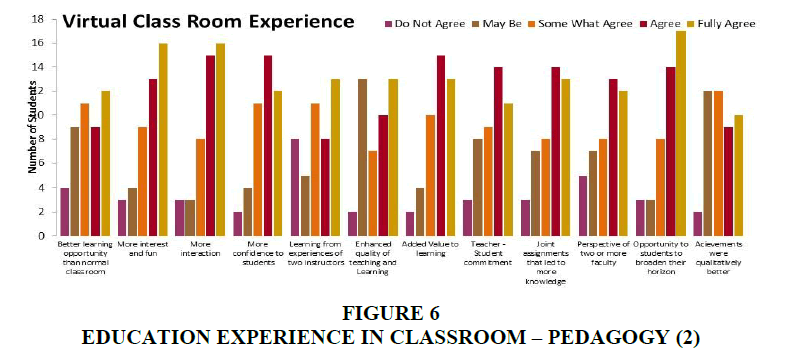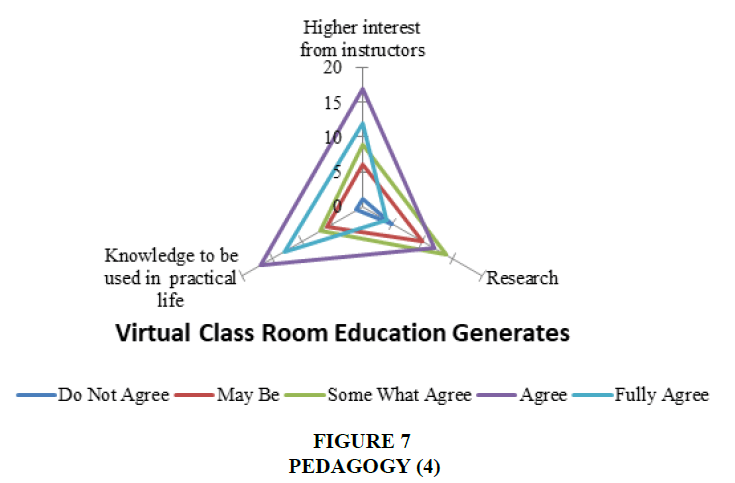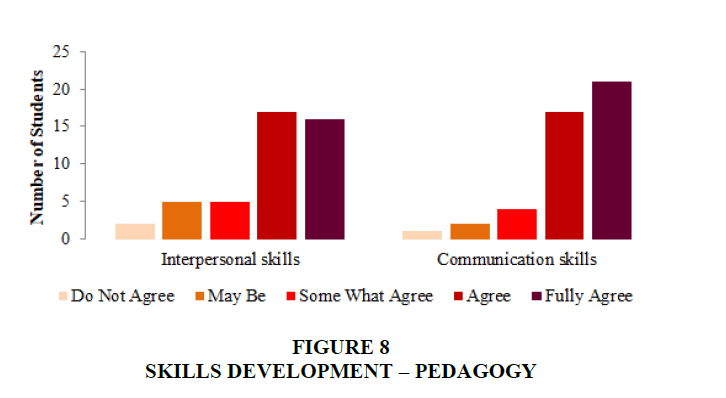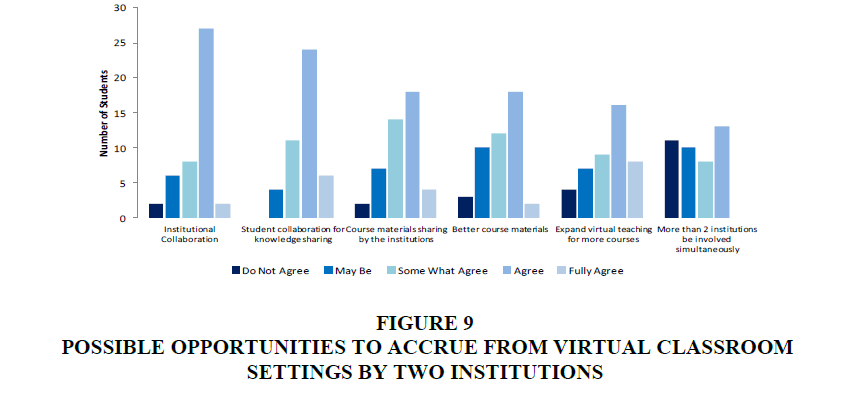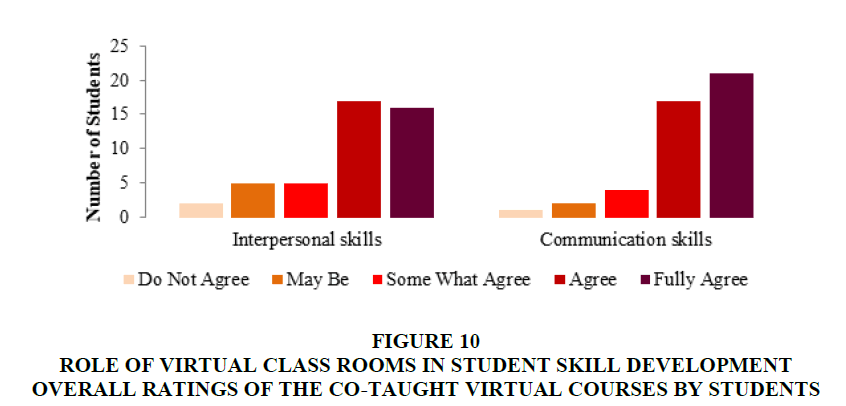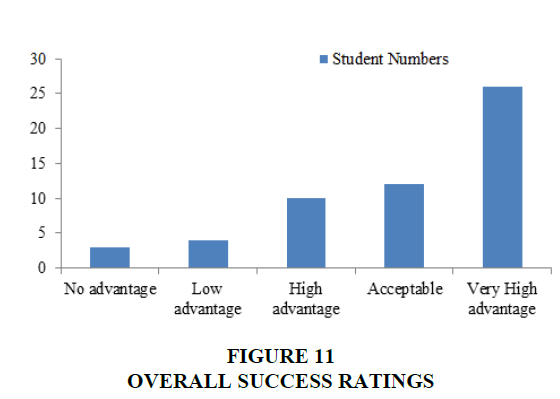Research Article: 2022 Vol: 26 Issue: 4
Value recognition by students on co-taught virtual entrepreneurship courses
Khan Rahatullah Muhammad, Effat University
Citation Information: Muhammad K.R. (2022). Value recognition by students on co-taught virtual entrepreneurship courses. International Journal of Entrepreneurship, 26(4), 1-18.
Abstract
Concrete and widely available evidence for effectiveness of virtual co-taught classrooms from most important stakeholder i.e. the student is lacking. It is the student who receives the education the way policy makers’ desire. However, this paper provides an insight into student stand point on such courses. This paper provides student perception on the effectiveness of virtual co-taught courses from pedagogical and diverse angles to help faculty and policy makers. The study is based on quantitative survey carried on www.surveymonkey.net and the analysis using the SPSS and MSexcel of 55 participating students in a co-taught course delivered over one semester at two institutions in USA and Saudi Arabia. The students were asked the questions related to existing pedagogy, role of technology in education, co-teaching over internet and others. It was designed to understand the benefits, challenges and future role of such courses from student perspective. Results show virtual classrooms co-taught by instructors from diverse cultural backgrounds, locations, expertise and approaches is indeed a success. Virtual classrooms will stay and define our future teaching pedagogy and learning.
Keywords
Virtual Teaching, Student Perception, Co-Teaching.
Introduction
How can we teach students if we do not know how they learn and their understanding of effectiveness of the teaching strategies and pedagogies we apply to help them learn, improve, be a better person and contributor to the society. It is the learner who is, for the most part, in charge of what he/she learns. Our job as academics and planners is to keep innovating strategies aimed at maximizing the learning experience of the students.
Use of Internet in teaching is common and widely acceptable and practiced. However, co-teaching in a virtual class room to students of two different institutions is new. We also do not have concrete and usually available evidence for its effectiveness from the most important stakeholder i.e. the student. This study aimed to understand efficacy of strategies employed in two courses co-taught virtually in a Saudi (Effat University and US (Hope College) Institution. The course taught was Inter Cultural Communications at junior and sophomore levels for undergraduate degree in business. Both the institutions are members of the Global Liberal Arts Alliance (GLAA). The co-taught courses are announced and coordinated by the GLAA.
The two instructors from these institutions exchanged the syllabi and made minor adjustments in the study and teaching plans to fit requirements students from both institutions. The details of the students’ performance and brief profile were exchanged. The course was taught over the use of internet through skype sessions. Each week 2 sessions of 1 hour each were held. Each session led by instructor of respective institutions.
The students were distributed in mixed groups where they carried out assignments together and presented virtually by the group. The course topics were equally divided among the faculty who delivered teaching during their respective sessions. The course coordination was carried out by the instructors. Student questions were answered mostly by both the instructors during the live Skype video calls.
The results show that virtual class rooms co-taught by the two instructors from diverse cultural backgrounds, locations, expertise and approaches are indeed a great success. These classrooms are here to stay and define our teaching pedagogy and learning in the 21st century. This study will set a path and help guide strategists to develop future plans and tactics to commence co-taught virtual learning courses.
Literature
The traditional classroom has been dominated over the past 50 years by a teacher-centered approach to teaching (Roland, 2014; Feden, 1994). Lecturing, modeling, instructing, illustrating, demonstrating, and coaching have remained the main teaching strategies-of teacher centered approach (Brown, 1998; Castling, 1996). These strategies mainly involve the teacher in making a formal exposition of a desired teaching content.
On the other hand a student-centered teaching approach focuses on empowering the learners by providing them with sufficient guidance, practical experience, meta-cognition, and self-evaluation through small-group interaction (Withycombe et al., 2016; Kliegl & Weaver 2014). Its teaching strategies may include group discussions, debates, simulation games, role-playing, case studies, projects, field trips, cooperative learning, and problem based learning. These strategies are however ‘process oriented problem based, contextual, interdisciplinary and meta cognitive in nature’ (Brown, 1998)
As professional teachers, academics are facing a difficult challenge from learning technologies, as they have to renew and develop their model of the learning process well beyond the traditional transmission model (Essed & Muhr, 2018; Schön, 1987). Exploration of an innovative strategy requires a teaching approach to turn academics into reflective practitioners as professionals in teaching and research Wenger (1998).
A new teaching and learning approach is fast becoming reality with the help of Internet Min Wu et al. (2008). It is an open, flexible and technologically accessible means of dissemination and communication. It is also a powerful tool for breaking the limitations of time and space that exist in traditional forms of teaching and learning Peter and James (2006). Hence the term virtualization is gaining ground. Virtualization of the learning process through the use of IT equipment based on Internet is becoming popular (Sabo et al., 2015; Uceda & Senén, 2010). They also assert that as online teaching and learning is faculty-delivered instruction via the Internet. Two parallel processes take place in such an environment and these are that students become more active and reflective learners and students and teachers engage in learning through the use of technology. This helps them become more familiar with technology.
Online teaching and learning is most effective when delivered by teachers experienced in their subject matter (Bersin, 2002). The online teaching and learning approaches of ‘synchronous’ and ‘asynchronous’ (which is learning takes place any time anywhere) are known; Berge, 1995; Feenberg, 1998). Synchronous learning includes live chat, audio and video conferencing etc. Whereas, asynchronous learning methods use the time-delayed capabilities of the Internet including e-mail, threaded discussion (Roland, 2014). Web based Learning Primer. Online teaching and learning may also help to adopt student-centered teaching and learning and help students become more versatile learners (Withycombe et al., 2016; Berge, 1995; Bersin, 2002).
Another form of teaching and learning approach is collaborative learning. It helps the students become more active participants in the learning process with easy access to global resources. It helps the students to easily access online databases in the online classroom (Uceda & Senén, 2010). Experiential learning through multimedia presentations utilizing new technologies can be used to engage and motivate the students (Kliegl & Weaver, 2014; Brian, 2012).
Teaching online offers the advantages like the opportunity to think about teaching in new ways; provide ideas and techniques to implement in traditional courses, expand the reach of the curriculum, professional satisfaction for instructors and instructor convenience (Laurie, 2011). Some of the challenges for instructors of teaching online include familiarity with the online environment, capacity to use the medium to its advantage, being available to students on an extended basis electronically, providing quick responses and feedback to students (Massy & William, 2002; Castling 1996).
On the other hand posit that the three primary challenges associated with online teaching are effectively structuring online courses, creating community in virtual classrooms and facilitating and encouraging online discussions. Structuring an online course includes course planning, course organization and communication.
Bruner, 1960 asserts that the pedagogy is the science and art of education. Its aims range from the full development of the human being to skills acquisition and different techniques and tools applied by teachers to help students learn. According to Lawrence (1999) it is important to develop online communities in the classes being taught. Creating community includes student-to-student interaction, faculty-to-student interaction, allowing students to post student-to-student communication to get answers to questions, pair each student with a “buddy” in the course, encourage peer response, structure opportunities for personal interaction.
Another interesting and pertinent report by Regalbuto (1999) on “Teaching at an Internet Distance: the Pedagogy of Online Teaching and Learning”, a sense of group and community among electronically assembled individuals can be created by a combination of team building activities, facilitation skills, and conferences for specific groups and tasks. It suggests that faculty-to-student interaction and principles of good practice highlight the importance of faculty-student interaction in promoting learning in such environments.
GAPS
This discussion shows use of Internet in teaching is on the rise and widely acceptable and practiced. However, we do not have the concrete and widely available evidence for its effectiveness from the most important stakeholder i.e. the student, the customer and especially in entrepreneurship related courses.
Keeping the literature in view the researcher aimed to carry out a detailed survey of the students who have taken virtual co-taught courses. Two such institutions were identified. Their names are not revealed due to permission not granted from institutions to use their names. However, the consent was given to conduct the survey, analyze the findings and provide recommendations.
Researcher intends to bridge the knowledge gap on student value perspective on the virtually co-taught courses. The higher education institutions spend huge funds on providing the right education to the students. They carry out expensive research and develop the curricula to enhance student experience and achieve certain learning outcomes. However, we have limited knowledge on student perspectives that how can these learning outcomes be better achieved. This study aims to seek answers of following questions.
• What is student value perspective on virtually co-taught entrepreneurship courses?
• What is the student perspective on knowledge acquisition through such courses?
• What is the student perspective on benefits for students of such courses?
• What is the student perspective on acquiring intended learning outcomes?
This paper based on the following methodology will attempt to understand the perspective of the students of co-taught virtual entrepreneurship courses on feasibility as teaching pedagogy and learning mechanism.
Methods
Research Design
A business cannot succeed unless it is customer centric. Therefore, in order for the co-teaching to succeed, the researcher planned to reach out to the customer (students) to know their perspective and identify the triggers of satisfaction on this relatively newer concept. If faculty does not know the standpoint, needs, expectations and requirements of the students from such courses, these might not succeed.
Design Stages
The following Table 1 shows the stages of research this study went through.
| Table 1 Research Stages |
|
|---|---|
| Stages | Explanation |
| Exploration | The study explores the literature on co-taught courses to develop a scholarly view of the co-taught courses in higher education. |
| Identifying Gaps / Conceptualizing | The next stage was to conceptualize the research. Identifying gaps and developing execution strategy. |
| Execution | Detailed look at methodology is provided to develop appraisal of the appropriate methods to investigate and analyze the results. |
| Data presentation and Discussion | At this stage the data had been collected with the help of the international counterpart. The data was then analyzed and presented with the help of statistical tools including SPSS. |
| Conclusions and Recommendations | The data analysis and discussion assisted to draw conclusions and make recommendations in light of the findings. |
Validity and Reliability Issues
It is a repeatable, systematic procedure to produce validation results. The specific aspect of validation methods as opposed to a general view of methods is that user validation always starts with an objective and assessment criteria. The analysis of the research methods is completed by a validation exercise carried out in order to assess the content and face validity of the results through measures stated below.
• Validity of measure in quantitative research
• Questionnaire design effects, problems and considerations
At the end of the course an online survey was conducted and 55 out of the 59 involved students responded giving more than 93% response rate. The questionnaire was developed on 5 ratings scale of, Do not agree (1), May be (2), somewhat agree (3), Agree (4) and fully agree (5) with the statement. The aim of survey was to understand students’ standpoint on a variety of issues related to a co-taught entrepreneurship course in virtual settings including following.
• Attributes of Teaching and Learning in a co-taught virtual classroom
• Benefits of virtual class room learning
• Challenges that arise in the virtual class room for the students, including effectiveness of the use of IT and Internet, the use of multicultural teams for assignments and projects, teaching and Learning across cultures and borders
• Pedagogical approaches and their effectiveness in virtual classroom, it includes Teaching Strategies adopted and which ones could be more successful, skills development in virtual classroom setting and what to do in order to help students acquire knowledge. It also identifies the effective learning methods and role of virtual classroom in developing Cognitive skills of the students and what do students think of the experience of such an environment
• Accruing opportunities for students, faculty and partnering institutions
• Overall success of the virtual Teaching and Learning
The entrepreneurship course of “starting new business” was co-taught in virtual online environment. The survey instrument was placed on www.surveymonkey.com and the students of both the class rooms in Saudi Arabia and USA participated. The data was then downloaded in SPSS for analysis and presentation. A pilot study for survey was conducted and seven Saudi Institution students participated and minor changes asked for were incorporated. The survey was placed online on December 11th and results obtained on December 30, 2012. The students were sent emails and were reminded twice during this period. As the names of the institutions cannot be revealed, the institutions are located in Saudi Arabia and the USA. The institutions would be labelled in the following sections as Saudi and US institution.
Data Presentation
The degree duration of the students from Saudi Institution was five years whereas it was four years in respect of the students of US Institution. Majority of students from Saudi Institution were from year 1 and year 3, whereas, from US Institution year 3 and 4 students attended these courses. The number mix of the student maturity seems normally distributed at the different levels of the degree, i.e. except 2 students from year 5 at Saudi Institution all other respondents were from among year 1 to 4 (Figure 1).
Results and Discussion
This section shows results and discusses the possible implications of the answers. The results and discussions will be carried out on teaching and learning attributes, benefits, challenges, pedagogy, classroom experience, skills development and opportunities. Correlations are carried out in the end between the benefits and challenges and pedagogy for further clarity.
Teaching and Learning Attributes
The following Table 2 and Figure 2 identify the student perspective on the attributes of the co-taught virtual classrooms. It shows that the majority of students are of the standpoint that in the virtual classrooms the workload gets heavy for them. However, there is also a notable population of respondents disagreeing with the majority Table 3.
| Table 2 Student Levels At Two Institutions |
|||
|---|---|---|---|
| Level of Studies* 'Student at Cross tabulation' | |||
| Level of Studies | Student at | Total | |
| Saudi Institution | US Institution | ||
| Year 1 | 10 | 3 | 13 |
| Year 2 | 5 | 4 | 9 |
| Year 3 | 9 | 10 | 19 |
| Year 4 | 2 | 10 | 12 |
| Year 5 | 2 | 0 | 2 |
| 28 | 27 | 55 | |
| Table 3 Teaching And Learning Attributes In A Virtual Classroom |
||
|---|---|---|
| Descriptive Statistics | ||
| Mean | Std. Deviation | |
| The argument and evidence becomes norm | 2.9111 | 1.20269 |
| The workload can get heavy | 3.2000 | 1.05744 |
| The course becomes concept central | 3.3111 | 1.16428 |
| Principles and concepts are practically looked at | 3.4000 | 1.09545 |
| There is more active interaction | 3.7500 | 1.22237 |
| Course content becomes linked to real life | 3.8222 | 1.13396 |
| Valid N (listwise) 54 | - | - |
Majority of the students (with little variation from norm in the answer pattern realized from standard deviation) express their belief in such courses and suggest that these are very practical and applicable to the real life. Similarly, responses also suggest that the interaction in the class and the practicality of the concepts is central to the teaching and learning in these environments.
Benefits of the Co-Taught Virtual Class Room
The figure 3 shows the viewpoint of the students regarding possible benefits they gained from co-taught virtual classrooms.
Looking at the numbers 0 to 30 are the student respondents, it seems that gaining experience and new knowledge, enhancement of the learning opportunity and learning of new culture have been identified as major benefits of the co-taught virtual courses. Looking at the student learning stage, it shows that the students seek acquiring of ‘new knowledge and knowing culture’ as more important benefits. The students also regard it as important experience. Comparatively smaller number of students regards it as opportunity to make new friends, gain experience and learn new culture.
This is perhaps due to the fact that the co-taught virtual courses are organized across boundaries and when such an opportunity arises it assists the students to expand their horizon and learn more. The students response seemed a little cautious in making friends, this is may be owing to the fact that they require more time to acquaint themselves with each other and that knowing better each other may require meetings as well other than online.
Challenges in the Co-Taught Virtual Classrooms
The following chart in figure 4 shows that the students think that managing differences in different cultures is a challenge. The virtual co-teaching is supposed to happen in two different institutions and in this case it was two countries with a time difference of 8 and nine hours in summer and winter timings. The students pointed out that managing the time difference is another challenge, the policy makers and colleges and universities contemplating such alliances may take into account. Such a difference can mean that students and instructor(s) of at-least one institution have to make sacrifice of their time and they might need to be compensated for it. Similarly, the students note the issue of internet connectivity, online meetings and sound system. There were a number of assignments to be completed in a team. This increased workload on the students and they also found it hard to find time and get connected with the colleagues in two different countries because of the time difference.
This future virtual classroom would need to be better equipped and time differences should be managed. Likewise, it is important that the institutions collaborating must take into account the difference of the time zones they are in.
Table 4 shows that the younger students of year 1 and 2 consider the skype experience and technology as major challenge. They also think that due to this the completion of the course content may become difficult. This also shows their maturity level. Getting connected with counterparts from other institution is a challenge for students except the year 3 pupils who recognize it as comparatively less of it. The students from year 4 and 5 take the projector system, time difference and skype as main challenge. It means that students are fully aware of the issues and challenges that may arise in their class rooms and they feel cynical.
| Table 4 Challenges Of The Co-Taught Virtual Courses |
|||||||
|---|---|---|---|---|---|---|---|
| Challenges | Mean | Std. Deviation | Level of Studies | ||||
| Year 1 | Year 2 | Year 3 | Year 4 | Year 5 | |||
| Mean | Mean | Mean | Mean | Mean | |||
| Technologically well-equipped class rooms | 2.8889 | 1.24722 | 3.38 | 2.75 | 2.56 | 3.30 | 2.00 |
| The Sound system | 2.9556 | 1.31349 | 3.75 | 3.25 | 2.94 | 3.90 | 2.00 |
| Getting connected with colleagues | 3.0000 | 1.27589 | 3.63 | 3.50 | 2.76 | 3.44 | 5.00 |
| Managing time difference between two countries | 3.0222 | 1.48460 | 3.38 | 2.38 | 2.83 | 3.40 | 2.00 |
| Coverage of course syllabus | 3.0682 | 1.35368 | 3.38 | 2.88 | 3.17 | 3.00 | 2.00 |
| The Mike system and apparatus | 3.0889 | 1.14460 | 3.13 | 2.63 | 3.11 | 3.50 | 2.00 |
| The Projector system and appratus | 3.0889 | 1.18364 | 2.25 | 3.00 | 2.89 | 3.80 | 4.00 |
| Time management during course | 3.1163 | 1.33112 | 2.50 | 3.25 | 3.00 | 3.10 | 4.00 |
| Existing skype experience | 3.2558 | 1.19708 | 3.38 | 3.38 | 3.22 | 3.20 | 4.00 |
| Managing differences in two diverse cultures | 3.2889 | 1.19891 | 2.88 | 3.75 | 3.00 | 3.00 | 3.00 |
| Skype or any other communication tool | 3.3333 | 1.22474 | 3.00 | 3.57 | 3.00 | 2.80 | 4.00 |
| Valid N (listwise) | 55 | ||||||
Pedagogical Approaches and their Effectiveness
The Figure 5 shows that majority of the students agree that the co-taught virtual classrooms provide more opportunities to reflect and think about the subject matter and lecture topics. This could be because the co-taught virtual classrooms in disguise develop a sense of competition between students’ from two distinct institutions. This can act positively in achieving course and learning objectives set. Similarly, the students agree that such courses provide more opportunities for in and out of class discussions and lecture become more interactive.
The figure 5 reveals that less than 10% respondents’ believe that co-taught virtual classrooms do not provide the better opportunity to learn. Overwhelming majority of more than 95% assert that these classrooms are more interesting and fun generating while educating with increased interaction from two instructors. The increases the confidence level of the students and the quality of both teaching and learning is enhanced. Correspondingly, more than 93% students responded that these courses added to the learning value and showed great deal of instructor – student commitment and students achieved more than in student/teacher centered lectures.
Students were asked to respond on their likeness of strategies adopted and possible benefits and reasons for liking. The Table 5 above shows that new values accrue from co-teaching. The students seem to agree that the diversity of presentations, increased interaction with two instructors and learning from their experiences provided more room for reflection. The students also showed interest in joint assignments that led to understanding cultures and making friends across the borders.
| Table 5 Pedagogy |
|||
|---|---|---|---|
| Pedagogy, Teaching Strategies | Std. Deviation | Pedagogy, Teaching Strategies | Std. Deviation |
| Presentations | 0.4341 | Teacher - Student commitment | 0.2362 |
| Research | 1.1481 | Joint assignments | 0.2505 |
| Course Project | 1.2898 | More confidence to students | 1.1119 |
| More student - instructor interaction | 0.3551 | Higher interest from instructors | 1.0745 |
| Better achievements qualitatively | 1.2177 | Added Value to learning | 0.1232 |
| Learning from two instructors | 0.4557 | More interest and fun | 0.2227 |
| Better learning opportunity than normal class room | 0.3169 | Knowledge to be used practically | 1.0908 |
| Reflection | 0.1947 | More interaction | 0.1862 |
| Enhanced quality of teaching and Learning | 0.3054 | Opportunity to students to broaden their horizon | 0.1985 |
| Assignments | 1.0869 | Discussions with peers | 0.2996 |
| Perspective of two or more faculty | 0.3409 | Class Discussions | 1.1160 |
| Concept clarity by instructors | 0.2362 | ||
However, it is also evident that the students showed that the co-taught virtual or normal classroom teaching and learning provides similar outcomes and generate interest regarding research and use of knowledge in practical life. It is also evident that according to students these courses will develop their communication skills which may be because of several factors like discussions with partners from other institutions, amount of classroom interaction and discussions. Looking at the number of students responding on x axis in figure 6 or in figure 7, the students were asked to opine whether and to what extent they agree that the knowledge acquired in the classroom is usable in practical life, such environment generates more interest for teachers and opportunity to research. The view of the students’ show that respondents agree largely that the instructors show more interest and the knowledge students acquire is practical in nature that can be used in their practical life. Students also have agreed that such classes generate more opportunities for research for them. It may be because the instruction comes from two teachers who want their students to conduct investigation into diverse areas.
Achieving Skills Learning Outcomes
Similarly in order to understand the student opinion regarding skill development in a co-taught virtual classroom they were asked to rate if the class room experience provided them opportunities to develop communication and the interpersonal skills. However, it is not the case that interpersonal skill ability does not occur. It entails that students’ better interpersonal communication happened interacting their counterparts.
Opportunities Presented By the Co-Taught Virtual Classrooms
The students shared their views on conducting such courses identifying that such courses may generate future collaboration opportunities for the institutions and develop better course materials. It is seen that majority of the students agree to the fact that these classrooms will generate collaborations at both the student and institutional levels. This identifies importance students attach to such an environment for knowledge acquisition(Figure 8 and Figure 9).
Value Perception
A number of benefits were identified by the students as shown in preceding discussions. In order to understand the student value perception of the virtual co-taught courses the benefits were correlated with certain value propositions as enumerated in the literature and developed by the researcher as possible values through brainstorming with students.
The above correlations show that learning from the experiences of the two instructors enhances the student exposure even more. It also provides students with an opportunity to broaden their horizon, reflect, complete their assignments and course / project work in a better manner. This provides them with valuable experience and enhances their learning emanating from two instructors. The students also seem to suggest that this environment of learning and teaching is better in order to have concepts clarity and engage with their counterparts from participating institution(s) (Table 5).
It can be implied that this provides students with new knowledge and presumably may augment student – instructor commitment. This satisfies what Bersin (2002) opined that the class discussions are considered vital to enhance learning, add value and achieve better quality in assignments and course work. Since the quality of teaching is enhanced as two instructors provide their views, feedback and lectures. These are from different perspectives. Similarly, the class discussions are more diverse and multicultural. The assignments are completed by the students groups working together from across borders. The responses show that these help gain better experience for the students. The interest, interaction and learning from experiences of two instructors improves the learning experience. Similarly, new knowledge is acquired through class discussions and the virtually co-taught courses opened avenues to learn more about the new cultures.
Skill Development
Numerous higher education quality frameworks for the teaching and learning in higher education rate learning outcomes of ‘communication’ and ‘interpersonal’ skills (Nkhoma et al., 2014; Havnes & Prøitz 2016; Rahatullah, 2014) acquisition by the students as integral and important part of class room experience. The Figure 10 below shows that students agree that virtually co-taught courses help increase interpersonal and communication skills.
Figure 10: Role Of Virtual Class Rooms In Student Skill Development Overall Ratings Of The Co-Taught Virtual Courses By Students.
Students were asked to rate overall success of the co-taught virtual courses. Following Table 6 and Figure 11 show that they highly rated the success of these courses. In all forty eight students rates the course as acceptable to high and of very high advantage.
| Table 6 Correlations Between Benefits, Challenges And Pedagogy |
||||||||||
|---|---|---|---|---|---|---|---|---|---|---|
| Value Accrued | ||||||||||
| Benefits | More interest and fun | More interaction | Learning from experiences of two instructors | Enhanced quality of teaching and Learning | Joint assignments that led to more knowledge | Opportunity to students to broaden their horizon | Acievements were qualitatively better | Class Discussions | Discussions with peers from other institution | Concept clarity by instructors |
| Enhanced exposure in the area of the course | 0.333 | 0.353 | .427** | 0.388 | 0.2370588 | 0.418 | 0.319 | 0.1982954 | .217** | 0.26224552 |
| 0.3117217 | 0.2177172 | 0.0048337 | 0.1109582 | 0.1306376 | 0.6005922 | 0.593945 | 0.2080796 | 0.0340951 | 0.093393481 | |
| Gained experiences | 0.384 | 0.481 | 0.31 | 0.2399452 | .559** | 0.478 | 0.25639 | .215** | 0.363 | 0.194456015 |
| 0.109991 | 0.1080108 | 0.4036955 | 0.0121189 | 0.0200097 | 0.201175 | 0.0969968 | 0.0155711 | 0.1686271 | 0.21147228 | |
| Enhanced learning opportunity | .386** | .498** | .451** | 0.603 | 0.299 | .405** | 0.513 | 0.411 | 0.459 | .527** |
| 0.009618 | 0.0005823 | 0.0021135 | 0.1000015 | 0.4841748 | 0.0064613 | 0.8900369 | 0.60056 | 0.8017431 | 0.010024045 | |
| New knowledge | 0.386 | 0.424 | 0.46 | .418** | 0.1386531 | 0.503 | .418** | 0.28329 | 0.1500806 | 0.342 |
| 0.1060978 | 0.8046339 | 0.8001909 | 0.005331 | 0.3752344 | 0.1100059 | 0.0052467 | 0.0656465 | 0.3367533 | 0.492728811 | |
| Learned about new culture | 0.391 | 0.416 | .460** | 0.33 | 0.0786829 | 0.508 | 0.375 | 0.1845037 | 0.2661708 | 0.295023554 |
| 0.8686451 | 0.1004936 | 0.0163464 | 0.2870824 | 0.6116735 | 0.9900055 | 0.1225915 | 0.2305465 | 0.1807402 | 0.051878188 | |
N=55
**. Correlation is significant at the 0.01 level (2-tailed).
*. Correlation is significant at the 0.05 level (2-tailed).
There were however, 7 students who are unconvinced of the experience and they rate it of low advantage or of no use. Their percentage is 12.7. Nonetheless, the percentage of respondents who rate it successful is more than 83%.
Conclusion
The above discussion reveals that the co-taught virtual class room experience is success. The academia has to develop the teaching strategies that can capture the pedagogies emphasized by the students as effective. Similarly, there is a great need to develop the technology infrastructure before embarking into this venture.
In such an environment the courses become more concepts central and linked to practical life experiences. Co-taught virtual classrooms are great source of motivation for the students as they learn about new cultures and it increases their exposure to the subject and provides opportunity for enhanced learning. The future virtual classrooms would need to be better equipped and time differences should be managed.
The study has answered the questions raised to an extent that warrants change in our approach to develop courses. The students seem to like the innovative approaches to the education and learning.
The practical courses where the students need to perform jointly in assignments and other forms of assessments, a co-taught virtual classroom would be a viable proposition.
The co-taught virtual classrooms may offer blessing in disguise by developing a sense of competition between participating students’ and help in achieving course objectives and learning objectives set. This could also help in determining and setting the strategies for deep learning and holistic education.
The sound systems, the video conference tools and associated technology need to be perfect. This environment is positive, more interesting for both students and teachers, generates research, collaboration and partnering opportunities.
Recommendations
If the student perspective is not taken into account and if the institutions randomly kept on developing co-taught courses without knowledge of the student perspectives the pedagogy might not deliver the anticipated results.
The co-taught courses are gaining momentum and this study can set a path and help guide strategists to develop future plans and tactics to commence co-taught virtual learning courses.
A similar survey on a larger sample involving more students and faculty as well needs to be carried out. The concept may be taken further.
References
Berge, Z.L. (1995). The role of the online instructor/facilitator.Educational technology,35(1), 22-30.
Bersin, J. (2002). Measuring E-Learning’s Effectiveness: A Five-Step Program for Success. E-Learning
Brian T. (2012). Language Teaching, Language Teaching. 45(2), 143-179.
Brown, B.L. (1998). Applying constructivism in vocational and career education, Columbus, OH: Ohio state university, Columbus college of education, center on education and training for employment.
Bruner, J.S. (1960). The process of education, Cambridge, Harvard University Press.
Essed, P., & Muhr, S.L. (2018). Entitlement racism and its intersections: An interview with philomena essed, social justice scholar.Ephemera,18(1), 183-201.
Feden, P.D. (1994). About instruction: powerful new strategies worth knowing. Educational Horizons, 73, 18-24
Feenberg, A. (1989). The written world: On the theory and practice of computer conferencing.Mindweave: Communication, Computers, and Distance Education, 22-39.
Havnes, A., & Prøitz, T.S. (2016). Why use learning outcomes in higher education? Exploring the grounds for academic resistance and reclaiming the value of unexpected learning.Educational Assessment, Evaluation and Accountability,28(3), 205-223.
Indexed at, Google Scholar, Cross Ref
Kliegl, J.A., & Weaver, K.D. (2014). Teaching teamwork through coteaching in the business classroom.Business and Professional Communication Quarterly,77(2), 204.
Indexed at, Google Scholar, Cross Ref
Laurie P. (2011). The Benefits of Teaching Online, Webster Graduate School London,
Lawrence C.R. (1999) an Emerging Set of Guiding Principles and Practices for the Design and Development of Distance Education. Innovations in Distance Education. CAUSE/EFFECT journal, 22 (1); 1999.
Massy, William (2002). Distance Education: Guidelines for Good Practice. AFT, 9, 16.
Min Wu, Jin-Hua She, Gui-Xiu Zeng, Ohyama, Y. (2008) "Internet-Based Teaching and Experiment System for Control Engineering Course," Industrial Electronics, IEEE Transactions on, 55(6), 2386-2396
Indexed at, Google Scholar, Cross Ref
Nkhoma, M., Sriratanaviriyakul, N., Hiep, P.C., & Lam, T.K. (2014). Examining the mediating role of learning engagement, learning process and learning experience on the learning outcomes through localized real case studies. Education & Training,56(4), 287-302.
Indexed at, Google Scholar, Cross Ref
Peter, M.Y., James, N.C., (2006) Education about hallucinations using an Internet virtual reality system: A Qualitative Survey; Academic Psychiatry, 30(0005), 534-537
Indexed at, Google Scholar, Cross Ref
Rahatullah, MK., (2014). Role of Trust and Commitment in Building Successful Franchise Business Relationships; International Journal of Knowledge, Innovation and Entrepreneurship, 2(1).
Regalbuto, J. (1999). Teaching at an Internet Distance: the Pedagogy of Online Teaching and Learning. The Report of a 1998-1999 University of Illinois Faculty Seminar.
Roland, K. (2014). Creating a knowledge community: Embedded professional practice. Paper presented at the 321-327.
Sabo, S., de Zapien, J., Teufel-Shone, N., Rosales, C., Bergsma, L., & Taren, D. (2015). Service learning: A vehicle for building health equity and eliminating health disparities.American Journal of Public Health,105, S38-S43.
Schön, D.A. (1987) Educating the Reflective Practitioner: Toward a New Design for Teaching and Learning in the Professions. San Francisco: Jossey-Bass, 157, 311
Indexed at, Google Scholar, Cross Ref
Uceda, J. & Senen, B. (Coord.) (2010). UniversiTIC 2010: Evo -lu ción de las TIC en el sistema universitario español 2006-10. Madrid: Crue
Wenger, E. (1998) Communities of Practice: Learning, Meaning, and Identity. Cambridge: Cambridge University Press.
Indexed at, Google Scholar, Cross Ref
Withycombe Keeler, L., Wiek, A., Lang, D.J., Yokohari, M., van Breda, J., Olsson, L., Evans, J. (2016). Utilizing international networks for accelerating research and learning in transformational sustainability science.Sustainability Science,11(5), 749-762.
Indexed at, Google Scholar, Cross Ref
Received: 07-Mar-2022, Manuscript No. IJE-22-11463; Editor assigned: 10-Mar-2022, PreQC No. IJE-22-11463(PQ); Reviewed: 31-Mar-2022, QC No. IJE-22-11463; Revised: 29-Apr-2022, Manuscript No. IJE-22-11463(R); Published: 06-May-2022
